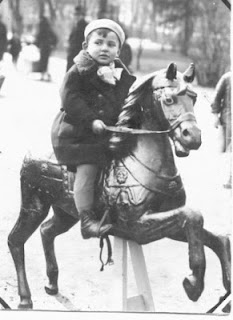I doubt Larry thought about the perpetuity of this gift as he carefully wrapped the blank journal. Larry, famous for his elaborate gift-wrapping skills, could turn an old newspaper, into art. He would color parts of the paper and paste a mosaic of photographs or special memorabilia. He literally metamorphosed the giftwrap into a collage worth framing. Finally, he would top it off with a piece of old string which he would fastened into an mesmerizing bow. I can only imagine the magnificent wrapping he must of concocted for his grandmother's 70th birthday present.
When Moma, carefully uncovered her gift—she must have used extreme care with Larry's elaborate creation, folded it neatly and set it aside—she found the following dedication:
"To my dearest Moma,
Dedication on the front
page of Moma's first Journal
signed by Larry and his wife Deborah
They call this book a "manuscript" book. Well, you don't have to to write a manuscript, but I hope you will use it to write down what ever you want: daily events, remembrances, your stories.
I am already looking forward to reading it. Have a good year.
I love you very much (and Deborah does too)
Larry & Deborah
The scene is called Dawn because it's on the 1st page of something new."Like all proud grandmothers, she must have beamed with joy at his expressed interest in her life. Yet, unlike most grandmothers, she took this request quite seriously. I particularly love the post script of Larry's dedication where he explains the dawn scene he sketched for her at the top of the page. He compares the first page of writing a memoir to the dawn of something new. What a beautiful image, to think of reminiscing into ones past as the dawn of something new. For more than a decade, she diligently wrote down her memories. One journal, turned into two and then many more. Her grandchildren impressed with her commitment to writing, continued buying her more blank books and encouraged her to keep going. Sometimes they asked questions or suggested writing topics. In 1981, when she passed away, she bequeathed to them hundreds of pages of her unfinished manuscript.
At first, the notebook was a great gift to Moma. She found much gratification in the process of writing and in knowing that her life was important to others. Then she returned it as a gift to her grandchildren who cherished and learned from it. Subsequently, it landed in my hands, the hands of the next generation, and changed my life. Her story—like most people's story—is not only her individual story, but part of a rich family tale. Finding her writing was like hitting the jackpot for a genealogist. The hidden pearls and gemstones within it's lines answered numerous questions about my family history. Eventually I turned her manuscript into a book. Stored Treasures, A Memoir, brings together her remarkable story—the one her grandchildren knew full well was worth preserving—with a large collection of my genealogical detective work. Now that "the stored treasures" of Minnie's life are out in the world and available on-line, the gift of a blank journal continues giving to a much wider audience than Minnie or her grandson ever envisioned.
Here is the amazing thing. One fan of the book, bought two signed copies recently. She wanted to give a copy, for Mother's Day, to both her mother and godmother. She planned to add a blank journal to each gift. Her present—like Larry's original gift—is a request to her "two" mothers to record their own legacy. She chose Stored Treasures, the story of an ordinary woman who lead an extraordinary life, hoping to inspire and make them believe that they also can write a Memoir.
Minnie was not a writer, yet her story reads beautifully, both because she wrote it from the heart, and because she got some help—from me, and my editors. Many people do not believe in their ability to write a memoir because they lack faith in the strength of their story and/or their writing skills. Neither is true. It is the ordinary things in life, which are amazingly special. One does not have to be an award winning author to record one's story for prosperity. Writing one's memoir is first and foremost gift to oneself and one's family and maybe one day to the rest of the world. If Moma had not jotted down her stories they would have been long lost and forgotten. But she did. And now, her gift, not only preserved a very personal view of an incredible period in history, but is inspiring others to pick up the pen and write their own story.
Happy Birthday Moma. Happy Mother's Day to all mothers, grandmothers and great-grandmothers out there. And maybe, this Mother's Day, think about giving the the gift that will keep on giving! Ask a mother, or a grandmother to tell her story! Trust me, she will love embarking onto the dawn of something new.












